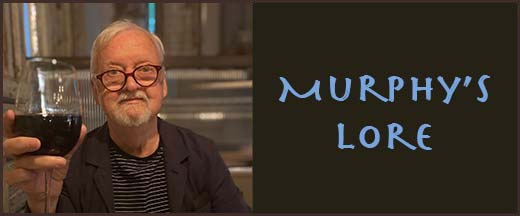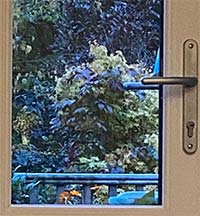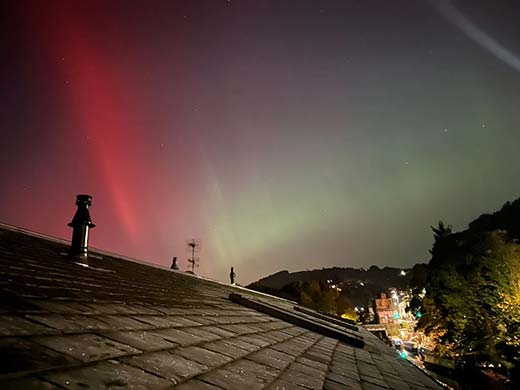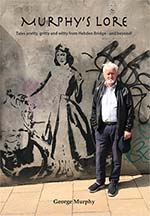
Fourth series, episode 19
All 151 episodes are available here on the HebWeb.
In the latest episode, there's Jesus in the garden, a book about the North, weather women dodging death, Steve and merry dancers, Liptrot on page and screen, children of a blood red cult and ancient tales still told.
 Jesus in the garden
Jesus in the garden
I was reading that people who are more credulous and believe in ghosts are more likely to see faces that aren't there. Then looking up … I saw the door handle on the French windows point to Jesus in the garden …
Northerners: a history
Reading a new book on the subject, It's strange to think that only one previous author has attempted to write a history of the north.
In 1990, Eric Musgrove described four periods of distinctive northern importance and power. In the third century, the term Britannia Inferior (not a put down, but meaning our distance from Rome) was created, when Emperors ruled the empire from York.
The second was the age of Bede, when Northumbria had an international sway and Geordie man Alcuin was appointed as the leading scholar at Charlemagne's court.
The third period was in the mid fourteenth to late fifteenth centuries, when the north's provision of manpower for wars in Scotland and France brought wealth and influence to its aristocratic families.
But the greatest period of importance was the industrial revolution, which changed the world and Britain's place in it. Now, former Financial Times assistant editor Brian Groom, having retired and returned up north to Saddleworth, has written a new history, his debut book. He points out that, with the decline of the old industrial north, our population has gone from 36.5 per cent in 1911 to 27.5 per cent and its share of Britain's output from 30 per cent in the 1920s to just 20 percent now. However, "its economy is still bigger than countries such as Argentina, Belgium, Denmark, Ireland, Norway and Sweden."
Groom believes a northerner is "someone who thinks of themself as a northerner." So, as a northerner, I'll report back on this new history "from the ice age to the present day," now that PW has let me read it. I gave her The Outrun in exchange.
Hurricane Milton
Thankfully, due to warnings from weather forecasters, and a change of direction, the hurricane that hit Florida didn't cause as much damage as was expected. After misinformation from Donald Trump and his supporters, Katie Nicolaou, a Michigan based meteorologist had been receiving messages claiming that the Biden government and meteorologists were creating Hurricanes.
"Hurricane Helene was an attack caused by Weather Manipulation," claimed a video shared by Michael Flynn, a former national security advisor to Trump.
As the rhetoric became more violent, Nicolaou wrote, "Murdering meteorologists won't stop hurricanes … I can't believe I just had to type that."
Steve and the Merry Dancers*
To explain … STEVE: Strong Thermal Emission Velocity Enhancement, appears during some aurora. The inspiration for the name came from an American animated film, in which a group of animals awake from hibernation and find a hedge has been planted. A squirrel suggests calling the hedge Steve, to make it less frightening.
There were warnings to look out for Aurora, and Steve too. But I didn't turn my smartphone to a nighttime setting when I went onto the balcony and pointed it towards Heptonstall. My phone saw the Northern Lights, and possibly Steve too, but not as sharply as the photos captured on our neighbour Nicola's camera - see below. She also saw flashes of vivid red light above the hills - with her own eyes. Which is what I'd like my eyes, one night, to see.

The Outrun at The Picture House
There was a packed audience for the film inspired by local author Amy Liptrot's autobiographical best-seller, to watch what proved to be a deftly directed account with a compelling, possibly award attracting performance by Saoirse Ronan.
Following the film, Hebden Bridge Film Festival Director Louise Wadley introduced Amy before conducting a Q&A, and the prolonged applause was probably fed by a heartfelt response to the writer's victory over alcohol addiction and the searing brilliance of her writing, as well as a celebration of the film. How much energy and field research the writer armoured herself with to assuage her addictive cravings.
If I'd taken courage to put my hand up, I'd have said, "What I could share from the film was memories of fearing for my children when they were nearing adulthood and worrying about them when they stayed out late, hoping they would be sensible and look after themselves, or had some friends to look after them." Also, "I was pleased the director included the book's celebration of Wi-Fi and its sky tracking wonders alongside the scenes of wild swimming and selkies!" Neither of my musings formulated into questions, and the questions from Louise and the audience were pithy and pertinent, so I kept stum.
Since then, I've read The Instant (2022), which records Amy Liptrot's year in Berlin, with more musings on the wonders and snares of the internet and a consideration of the freedom it offers single people, who work abroad whilst meeting work commitments in the UK. There's also a vivid and moving account of longed for passion and lost love. I've read somewhere that she wanted to 'put sex into nature writing'.
*The term Merry Dancers is from the glossary of The Outrun, it's an Orcadian description of Northern Lights.
Children of the Cult
ITV and ITVX and now in cinemas …
Sometime around 1980 we left our home at Foster Clough and moved to a cottage at Water Green in Soyland. The owner was Stan, a strikingly broad, tall, black bearded, one armed man, who worked in advertising. At one time the house (date stone 1671) had been visited by Cat Stevens, for whom Stan did some PR work. Stan wore orange robes, though it's apparent from this new film that later costumes took on a mandatory blood red hue. Stan and his partner were followers of the guru Bhagwan Shree Rajneesh (later known as Osho). They had seven children, whom his partner had taken with her to the cult's ashram in Pune in India. Stan was waiting to sell the house before flying out to join them. He left a day before the sale went through, leaving a ladder up against an open upstairs window and the keys inside the front room.
It took several days for us to clean the premises, finding items including a discarded false arm in the living room, rotting food on paper plates in the kitchen and porn magazines for swingers in the bedroom. With the south facing heavily beamed cottage we also became landowners, with the type of large garden we couldn't have at Foster Clough and an acre field, all for the princely sum of £22,000.
We were told by our new neighbours, that when members of the 'orange people' visited, they used to strip naked in the field and arrange themselves into a circle before howling and rushing together into a collapsing huddle in the long grasses of the unkempt field.
Now I'm not someone to tut over fun filled al fresco frolics, especially on private property, and there was never any suggestion from our neighbours (who must have clambered upstairs to their mullion windowed bedrooms to observe the ensuing orgy) that any children took any part in these events.
So we viewed Children of the Cult on ITV, expecting it to go over old ground, as we'd watched the acclaimed 2018 Netflix docuseries, Wild Wild Country, which told the story of the sex cult and the guru with 96 Rolls Royce cars and terror plots to kill members of the surrounding community in Antelope, Oregon. But recently women who were children of cult members in communes scattered around the world have come forward to claim they were treated like playthings by predatory adults during the 1980s and 1990s, and their own parents did not protect them. These former child victims are angry that no one has been charged over alleged offences, despite two of the men admitting to having sex with minors.
 Shonaleigh at Stubbings
Shonaleigh at Stubbings
Shonaleigh, a famous Jewish storyteller, is performing at Stubbing Wharf on the last Friday of this month, having learnt the Drut'syla tradition from the age of four. It was once the tradition in the Netherlands for the ancient Jewish tales to be passed from grandmother to granddaughter. But Shonaleigh believes she is the last surviving Drut'syla teller. Her repertoire consists of a matrix of thousands of tales and audience members are invited to intervene and sidetrack a story a bit like being part of a pin ball machine (my description), before her choice for the main tale reaches its conclusion.
Jewish folktales
So I've been revising my own knowledge of other folktales from the Jewish diaspora. Here's a tale from Chelm in South East Poland.*
Hang the cobbler
A great calamity befell Chelm one day. The town cobbler murdered one of his customers. So he was brought before the judge, who sentenced him to death by hanging.
When the sentence was announced, a townsman stood and cried out, "If your Honour please - you have sentenced to death the town cobbler! He's the only one we've got. If you hang him, who will mend our shoes?"
"Who?!" cried the good citizens of Chelm with one voice. The Judge nodded in agreement and reconsidered his verdict. "Good citizens of Chelm. What you say is true. Since we only have one cobbler, it would be a great wrong to the community to let him die. As there are two roofers in the town, let one of them be hanged instead!"
*From A Treasury of Jewish Folklore, compiled in 1948. (Before the German occupation in 1939, 3.3 million Jews lived in Poland. Three million of them were murdered in death camps).
Readers write
After completing episode 150, I got a note from the HebWeb Editor:
"Many many thanks to you George for all your great creations, storytelling, insights, anecdotes, fascinating snippets and morsels, informed commentary, forgotten yarns, tall tales, cock and bull, old chestnuts, unexpected revelations and so much more – all of which makes the HebWeb so much brighter . . . Chris."
Palestinian folktales
UNESCO have documented Palestinian Hikaye tales over the years. These were traditionally told by elderly women to an audience of young people. It's been a living culture, which has dwindled because of the attractions of television, gaming, the internet, and more recently, displacement and bombings.
Murphy's Lore, the book, is available to order here
If you would like to send a message about this piece or suggest ideas, email George Murphy
More Murphy's Lore
See the Murphy's Lore home page for all 151 episodes.


